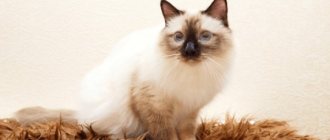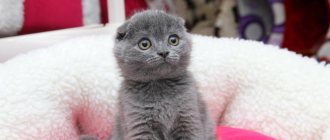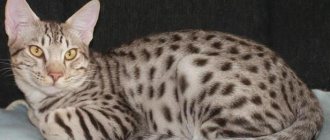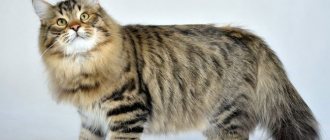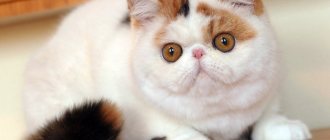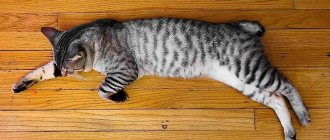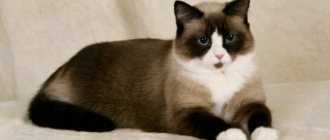The Burmese cat always makes an indelible impression not only with its unusual appearance, but also with its truly devoted, warm and sincere love for humans. She combines external menace and internal affection, personifying classic feline elegance and sophistication, mannerism and playfulness.
Looking into her large, honey-amber eyes and running your hand over her smooth, silky fur, you will selflessly and hopelessly fall in love with this purring little bundle!
If you are looking for a pet of this breed, our article today will help you navigate all the intricacies and tell you how not to make a mistake in choosing a bright representative of the cat world.
Video
* We invite you to watch a video about the Burmese cat . In fact, in front of you is a playlist in which you can select and watch any of 20 videos about a given cat breed by simply clicking on the button in the upper right corner of the window. In addition, the material contains quite a lot of photos. By looking at them you can find out what a Burmese cat looks like.
In this article:
|
Buy Burmese: recommendations
It is better to buy a cat of this breed in a specialized nursery, especially since this breed is not rare in our country. Only this approach can protect anyone who decides to have a cat of this breed at home. Depending on your preferences, it is enough to decide on the class of the kitten, which will determine its cost.
Alternatively, you can order a kitten, but if the kitten’s class does not play a special role, then you won’t have to wait long.
What to pay attention to
As mentioned above, it is better to go to a nursery that breeds cats of a similar breed. In this case, you should make sure that the kitten has all the accompanying documents.
It is advisable to buy a kitten aged 4 months or older, since all hereditary diseases will already appear. It is very important that the coat color of the kittens corresponds to breed standards.
Burmese cat price
Depending on the class, gender and color, a Burmese kitten will cost from 15 to 40 thousand rubles. Cheaper options are at risk, so it's better not to save money.
It must be remembered that some hereditary diseases can lead to the death of a pet. Therefore, by paying a little more, you can count on the fact that you will not have to be upset in life because of the health of your pet.
History of the origin of Burmese cats
The ancestors of the modern Burmese cat are aboriginal cats that have always lived in the territory of the state of Myanmar (in the past - Burma). The earliest mentions of them are found in documents from the 12th century AD. The Myanmarese (Burmese) have always treated these cats with great respect, considering them sacred, bringing good luck and prosperity, and allowed them to live in their temples.
Interesting fact: The first cat show attended by Burmese took place in 1871 in London. There was no furor, because for some reason the Burmese cats did not impress the public.
The modern history of the Burmese cat began in 1930, when the American doctor Joseph Thompson brought a mixed-breed Burmese-Siamese kitten named Wong Mao from Great Britain to the United States. Having matured, the cat greatly impressed the owner with her beauty. The doctor especially liked the brownish-reddish color of his pet’s coat.
Later, Dr. Thompson's pet was crossed several times with a Siamese cat, resulting in kittens of different colors, including chestnut and sable. The doctor continued to work on the breed and already in 1934 the first standard of Burmese cats was adopted. In 1936, the breed was registered with the CFA, but then only a single color was recognized - sable.
After several years of experimentation, breeders began to cross Burmese cats with cats of other short-haired breeds, resulting in the appearance of many half-breeds with a variety of colors - golden, blue, platinum.
The CFA did not approve of these experiments and in 1947 the registration of Burmese cats was stopped. Only those breeders who could fully confirm its pedigree in three generations had the right to register their pet.
A few years later, the CFA changed their minds and began to register Burmese cats with other colors, and in 1955, a blue Burmese cat made its debut at a cat show in London. The animal caused such great delight among the public that journalists even gave it an unspoken nickname: “The cat is a blue miracle.”
Burma gets along well with children
We often hear about nanny dogs, but we almost never hear about cats in this way. Burma is an exception to the rule. She gets along well with children and is drawn to them herself. But the most important thing is that the Burmese treat babies with trepidation. She never releases her claws, practically does not bite (if she does bite, it will be lightly), and does not show aggression. If you have such a cat in the house, you can rest assured about your children. An interesting fact: if a child is afraid of animals for some reason, then parents are recommended to get a Burmese. It will save the child from such fear.
Russian schools plan to start the next academic year in full-time format
How to wash, rinse and dry a blanket without a washing machine: complete instructions
Making a cute rug from old jeans. Looks beautiful and original
Burmese cat - description of the breed
The Burmese cat (Burmese) is characterized by a muscular, strong build and almost ideal proportions. This exotic beauty has short, very shiny and silky fur, which is often compared to mink fur. This cat also has an unusual, magnetizing honey-amber gaze, thanks to which in its homeland the animal was considered sacred and capable of leading the soul of the deceased to the afterlife in the shortest way.
The Burmese is a compact-sized cat. On average, its body length is approximately 50-55 cm, and its height at the withers is 21-25 cm. Despite its rather elegant appearance and ideal body proportions, the Burmese cat weighs not so little. This animal even received a nickname - “a stone wrapped in silk.” The weight of the cat is 5-6 kg, the weight of the cat is 8-9 kg.
This cat has short, silky fur that shimmers in the light. Until 1955, only one color was registered with the CFA - sable. Today the classic colors are: sable, champagne, blue, platinum.
Burmese cats are usually active, playful, sociable, delicate and affectionate. Moreover, the Burmese adhere to a similar line of behavior not only when communicating with their owners, but also with strangers. The oriental beauty is very smart, quite easy to train and easily adapts to family rules.
It is worth noting that Burmese cats are sometimes confused with Burmese. This is not surprising, because both of these breeds come from Burma (Myanmar). It is important to know that the difference between breeds is quite significant. After all, Burmese are long-haired cats, and Burmese are short-haired, reminiscent in appearance of miniature panthers.
Characteristics of the Burmese breed
The body is of medium size and length with a powerful chest and a straight back from the shoulders to the croup. The Burmese cat breed is also characterized by rather thin limbs and graceful oval paws. Its tail is of medium length, straight, gradually tapering to a slightly rounded tip.
The head has the shape of a short, blunt wedge with softly rounded contours and emphasized, widely set cheekbones. It is also characterized by a powerful chin and lower jaw.
The eyes are large and clear, widely spaced, the eye color is predominantly yellow-amber. The wide-set, fairly large ears are slightly inclined forward, with slightly rounded tips.
The fur of the Burmese cat is characterized as short, rather thin and shiny, satiny. It fits tightly to the body and has virtually no undercoat.
There are several color options: sable, chocolate, red, blue, lilac, cream, and tortoiseshell options based on them. The chest and belly are always lighter than the back. The standard does not imply the presence of any drawing. The points should be evenly colored, slightly darker than the body.
Disadvantages are pinch and sunken cheeks. Curious, does not tolerate loneliness.
Advantages include friendliness, good disposition, she gets along well with other pets, and is easy to care for.
Popular colors of Burmese cats
In addition to the peculiarities of physique and appearance, Burmese cats of the European type are allowed to have any coat color. It is worth noting that the European standard is not recognized by all international felinological organizations.
As for the American standard, everything is much stricter here, because real purebred Burmese are allowed to have only 4 main colors.
These include:
- Sable is a rich chocolate color with darker transitions to the face, tips of the paws and tail. All native Burmese cats originally had this color.
- Blue - this color can be either uniform or with darker transitions on the muzzle, paws and tail. A cat with this color was first presented at a London exhibition in 1955;
- Champagne is the color of coffee with milk. The paws, muzzle and tail are also darker;
- Platinum (lilac) - the most delicate light creamy shade of fur with a gray muzzle.
Burmese cats are also often confused with Siamese. And it’s all about the same darkening of the fur on the face, paws and tail. To clearly distinguish between these two breeds, you don’t need a lot of wisdom. It’s just important to know that Siamese cats have a less muscular build and always have blue eyes. As for the eye color of Burmese cats, they can be brown, yellow and green.
Thanks to the work of breeders who repeatedly crossed Burmese with Siamese, the list of their colors has expanded significantly. As a result, individuals appeared with cream, red, fawn, and tortoiseshell colors. Australian breeders have moved even further in their work on the breed and developed a Burmese with a white color.
Price
The Burmese cat is not so popular in the CIS, although it has its fans. Catteries are located in large cities, so you can study reviews about the breed and purchase a kitten in one of the offered places.
The cost of a purebred animal is from 200 to 500 dollars. The price of an individual depends on the class of the kitten. The pet class is intended for home keeping, the breed class for breeding, and the show class for participation in exhibitions.
When purchasing, pay attention to the following characteristics that are considered defects:
- oblong and elongated muzzle;
- round or oriental eyes;
- Aquiline nose;
- poorly defined cheekbones (hollow cheeks);
- tiger stripes (in adults);
- white marks on fur;
- strabismus;
- blue or pure green eyes;
- deafness;
- long tail with a sharp tip.
Character and habits of Burmese cats
Burmese cats are very loyal and loving pets. They literally idolize their owner and often become completely dependent on him. It happens that an animal follows its owner everywhere, like a dog, rubs against the legs, purrs, and at the first opportunity jumps onto the lap or onto the table.
After all, it is very important for him to be as close as possible to his adored owner. Due to their strong attachment to their owners, these cats do not tolerate loneliness very well and can even become ill if separated for too long.
Interesting fact: Burmese are very sensitive animals. They can easily determine what mood their owner is in, and if they feel notes of sadness or tension, they will immediately try to calm them down by gently purring. To sleep, these cats will most likely choose not a couch, but the owner’s bed, because they constantly need to feel the closeness of a person, to cuddle up to him.
Burmese cats are very smart. If you are patient, you can quickly teach them simple tricks - fetching objects, jumping over obstacles. Cleanliness is also very characteristic of the Burmese. Under no circumstances will a cat shit where it is not supposed to. At the same time, it is important for the owner to monitor the cleanliness of the tray, because the animal will not want to go inside if it is not cleaned.
Burmese cats are friendly not only to their owners, but also to strangers. True, at first they will look closely at strangers for some time, and only then allow themselves to be petted. Animals do not harm children and will tolerate literally anything from them.
Burmese are also very playful cats. Moreover, they have playfulness even at a very advanced age. For this reason, a cat play complex will not be superfluous.
Interesting facts about Burmese cats
There are legends about the Burmese cat's attachment to its owner. Their second unspoken nickname is “cats and dogs.” At the same time, there is a certain aristocracy and delicacy in the behavior of cats. These traits prevent pets from being overly intrusive or crossing the line of tact.
No one can say exactly how many centuries ago this breed appeared. According to old-timers, these cats have always lived in Myanmar temples - since the very moment of the creation of the world. Museums in Bangkok and Myanmar contain many paintings dating from the 14th to 18th centuries, which depict graceful cats very similar to the Burmese.
Ancient Asian books of poetry often mention cats that resemble Burmese. The date of writing of these books indicates the 5th-7th centuries AD. e. The Burmese cat doesn't look his weight at all. In fact, it is much heavier than it looks. For this reason, the Burma is sometimes jokingly called “a stone wrapped in silk.”
After the Europeans began breeding the Burmese, felinological organizations decided to divide the breed into two varieties: American and European. The reason for this division was the dissatisfaction of American breeders with the methods and aspirations of European breeders. Europeans wanted to improve the breed by crossing it with other short-haired breeds. Oddly enough, they succeeded.
The average lifespan of Burmese cats is approximately 15-17 years. Cats live so long thanks to their strong immunity. Burmese wool is considered hypoallergenic. However, allergy sufferers who want to have such a pet in their home should still talk a little in advance with Burmese cats.
Pros and cons of Burmese cats
The Burmese cat is a very beautiful, inquisitive, cheerful, playful and smart animal. Therefore, its owner will have to come to terms with the fact that the pet will literally idolize him, follow him everywhere and unobtrusively demand to pay at least a little attention.
Advantages:
- Beauty;
- Exotic appearance;
- Affectionate character;
- Playfulness and activity;
- Devotion to the owner;
- Tolerance towards children;
- Patience;
- Intelligence and intelligence.
Flaws:
- Love of adventure;
- Curiosity;
- Love for warmth (due to lack of undercoat);
- Excessive gullibility;
- Lack of fear of transport and strangers.
Many owners choose Burmese cats precisely because they can get along well with both adults and children. Animals literally allow children to do whatever they want to them without showing any aggression in return.
Burmese usually communicate with other animals courteously, even slightly arrogantly, clearly showing that they are the only kings here. However, they prefer to be friends with everyone rather than be at enmity. Of course, this friendship is always somewhat peculiar, but still. It is not uncommon for Burmese to become very attached to dogs, allowing them to lie on their bed and even eat from their bowl.
Overall, this is a fairly versatile breed that gets along easily with all family members. Homebodies will probably play with such a cat for a long time and teach it various tricks. The Burmese cat can easily learn to wear a leash, so you can walk it outside like a dog.
Workaholics and lonely people will have a more difficult time with this cat: the Burmese simply needs someone to be at home. Another cat or dog would be perfect for this. Still, with a friend the animal will have much more fun and not so lonely.
Education and training
Among all breeds, Burmese have a high level of intelligence, which is confirmed by many owners of these cats. They can easily open a closed door or reach for the switch to turn off the large “sun” under the ceiling. Having a sincere desire and patience, you can easily teach your dog simple commands: “Sit!”, “Lie down!” and bring the abandoned toy.
Burmese cats easily get used to the litter box and regularly use it as a toilet, so unexpected “bombs” in slippers and shoes will not wait for you.
Breeding Burmese cats
Many cat owners who want to breed them are primarily attracted by the prospect of easy money. At the same time, not all of them realize that this is a very serious work that requires considerable costs, both moral and material. The breeder must know and be able to do a lot: become familiar with the physiology of the cat, be able to give birth, provide first aid, etc.
Important fact: This is not at all as simple as it might seem at first glance. The breeder will also have to be responsible not only for their cat, but also for each kitten sold. He must be ready to correctly answer all, and sometimes even inappropriate and stupid questions asked by the owners.
Every potential breeder needs to understand that cats, including Burmese, are pedigree animals that have some predisposition to certain genetic diseases. So you will have to work according to unspoken breeder rules - culling kittens, removing them from breeding, conducting selection, and so on.
Now let's talk about breeding the Burmese cat. From the information above, it became clear that breeding is not an easy and very responsible matter. Therefore, it is necessary to take a responsible approach both to the selection of a suitable partner for the cat, and to further events: pregnancy, feeding a pregnant cat, childbirth.
It is also important to know that Burmese cats are characterized by early puberty - at 6-7 months. According to the rules of breeders, Burmese mating can be carried out after 2 or 3 heats. Physically, cats are capable of giving birth 3-4 times a year, but frequent births exhaust the body, which can affect both the health of the pet and the health of the kittens. The most ideal option is that in two years the number of births should not be more than three.
Has excellent health
Many cats that are bred as a result of selection, unfortunately, cannot boast of excellent health. But not the Burmese. The fact is that the homeland of this animal is a country in South Asia called Myanmar. It was from there that Thompson brought the cat to America. As a result of selection, excellent health and strong immunity have been preserved. What could be better than when a pet lives a long time and does not get sick?
Caring for Burmese cats
Caring for a Burmese cat is not at all difficult. Since her coat is completely devoid of undercoat, tangles never form on it. In order for the Burmese fur coat to look beautiful, it is enough to go over it with a brush with natural bristles or a Furminator once every 5 days. This way you can get rid of lost hairs. To give the fur a special satiny shine, you can use a piece of velvet fabric or suede.
Burmese cats do not need to be bathed often, especially if the animal does not go outside at all. Pets are given water treatments only 2-3 times a year, and it is better to do this before visiting an exhibition. For washing, you can only use special shampoos for short-haired breeds.
It is advisable to inspect and clean cats' ears with a damp cotton pad about once a week. Cats need to wipe their eyes (inner corners) daily, as this is their weakest point. Nails need to be shortened by 1 mm at least once every two weeks.
Your pet's teeth should also be given attention. After all, with age, tartar and dense plaque form on them, which often cause inflammation of the gums. To clean teeth, special cat pastes or special rough dental food are used.
Caring for a Burmese cat also includes responsibility for its health. Therefore, at least twice a year it is necessary to carry out deworming and preventive measures against infection with skin parasites. All necessary medications can be purchased at a veterinary pharmacy after consultation with a specialist.
Rules of care and maintenance
Even though Burmillas seem a little clumsy, they are very active, agile and jumping and will climb trees or special cat houses with great pleasure. That is why it is extremely important to purchase a reliable leash with a harness in case of a walk or trip out of town. Beware of drafts in the house: even despite their good health, these cats love warmth.
The Burmilla is characterized by stable health and stamina, so caring for it can be limited only to timely visits to the veterinarian and veterinary dentist to check the condition of the teeth.
In most cases, special oral care will also be required, which you can learn more about from your veterinarian.
About nutrition
Care also involves the use of high-class dry professional food, which will help remove plaque on the teeth, maintain the shine of the coat and the ideal complexion of the Burmilla. They will also happily enjoy boiled or stewed vegetables, cottage cheese, cheese and a small piece of butter. It is important to remember that caring for these pets does not involve the systematic consumption of “human” food and strictly prohibits feeding sausages, sausages, bread and other not the most healthy foods.
About fur and claws
Caring for the short hair of these beauties is extremely simple and does not require much effort or expense. During periods of intense shedding, periodic combing of the coat with a special brush will be required.
We recommend trimming the claws regularly, every 2-3 weeks. Make sure you have a comfortable scratching post in advance to instill good manners in your baby from the first days he is in your home.
Perhaps that’s all you need to know when purchasing a real mustachioed friend. We wish you to make the right choice, and we wish the new family member long and happy years of life!
Diet of Burmese cats
Typically, their owners, especially breeders, prefer to feed Burmese cats with premium industrial dry food. After all, its composition is correctly balanced and it contains all the substances necessary for the pet’s health: minerals, vitamins, microelements.
For individuals who are castrated or sterilized, special therapeutic and prophylactic feed mixtures are selected that help prevent kidney disease (KD) and contain a special set of vitamins and microelements. As an exception - not too often, you can offer canned cat food to your pets.
Products prohibited in the Burmese diet:
- Milk;
- Fried, salty, fatty;
- Legumes (beans, peas, lentils, etc.);
- Mushrooms;
- Nuts;
- Pork;
- Bones;
- Tomatoes and potatoes;
- Sweets and baked goods.
If the decision to feed the Burmese was made in favor of natural food, then it is necessary to think through its diet as carefully as possible and be sure to find time to prepare food for your beloved pet.
Products that you can and should feed your Burmese cat:
- Boiled lean meat (chicken, beef, turkey);
- Quail eggs;
- Low-fat fermented milk products (cottage cheese, kefir);
- Sea fish fillet (once a week);
- Boiled liver and heart.
Having chosen one or another type of food, it is important to stick only to it and under no circumstances mix them, because this is fraught with disorders of the pet’s digestive system and problems associated with it.
You also need to ensure that your cat’s drinking bowl is always filled with clean drinking water. In this case, the drinking bowl must be washed daily with a soda solution.
Diseases and health problems
Due to the different anatomical features of American and European Burmese cats, they also have a different set of congenital genetic diseases. For example, Burmese of the European type have long been no longer at risk of the hereditary disease GM2-Gangliosidosis, which is still found in the American type.
The disease begins with loss of coordination and ends with paralysis and death of the animal. In this case, the course of the disease can be very rapid - only a few hours. The peculiarity and complexity of the disease lies in the difficulty of its diagnosis. After all, the disease in kittens can only be detected after 3 months of age.
Another congenital condition is FCKS (flat chest syndrome), in which newborn kittens can have significantly deformed ribs and sternum. This disease is common to both types of Burmese. At the same time, in cats with this disease, two crises occur - on the 10th and 21st days. A kitten that has lived for more than three weeks acquires the ability to live a normal cat's life.
Also, Burmese cats are often diagnosed with a lack of potassium (hypokalemia). Symptoms of the disease: lethargy and fatigue. If the disease is not detected and treated in time, the pet may face paralysis. As a treatment for a sick animal, potassium is added to the feed.
Interesting fact: Burmese cats have one anatomical feature - a shortened nose, because of which they should be protected from colds.
Also, due to anatomical features, certain lines of American Burmese cats may experience serious difficulties during childbirth. Because of this, caesarean sections have to be performed in almost half of the cases. As for the European Burmese, they give birth very quickly and easily, rarely requiring surgical intervention.

